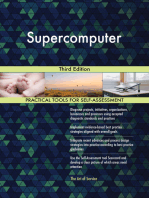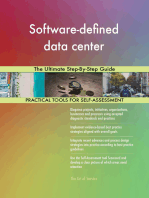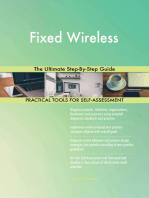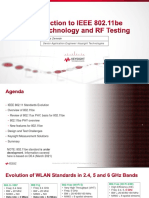0 ratings0% found this document useful (0 votes)
231 viewsInterim Report
Interim Report
Uploaded by
komalkasatThis interim report summarizes the implementation of a wireless mesh network using Alpine Linux. It discusses:
1) The goals of creating a mesh node using a laptop configured with Alpine Linux to allow wireless clients to connect to the network and internet.
2) Several common routing protocols for wireless mesh networks that were studied, including AODV, OLSR, and MMRP.
3) Plans to continue implementing and testing the wireless mesh network using these routing protocols in Alpine Linux.
Copyright:
Attribution Non-Commercial (BY-NC)
Available Formats
Download as PDF, TXT or read online from Scribd
Interim Report
Interim Report
Uploaded by
komalkasat0 ratings0% found this document useful (0 votes)
231 views3 pagesThis interim report summarizes the implementation of a wireless mesh network using Alpine Linux. It discusses:
1) The goals of creating a mesh node using a laptop configured with Alpine Linux to allow wireless clients to connect to the network and internet.
2) Several common routing protocols for wireless mesh networks that were studied, including AODV, OLSR, and MMRP.
3) Plans to continue implementing and testing the wireless mesh network using these routing protocols in Alpine Linux.
Copyright
© Attribution Non-Commercial (BY-NC)
Available Formats
PDF, TXT or read online from Scribd
Share this document
Did you find this document useful?
Is this content inappropriate?
This interim report summarizes the implementation of a wireless mesh network using Alpine Linux. It discusses:
1) The goals of creating a mesh node using a laptop configured with Alpine Linux to allow wireless clients to connect to the network and internet.
2) Several common routing protocols for wireless mesh networks that were studied, including AODV, OLSR, and MMRP.
3) Plans to continue implementing and testing the wireless mesh network using these routing protocols in Alpine Linux.
Copyright:
Attribution Non-Commercial (BY-NC)
Available Formats
Download as PDF, TXT or read online from Scribd
Download as pdf or txt
0 ratings0% found this document useful (0 votes)
231 views3 pagesInterim Report
Interim Report
Uploaded by
komalkasatThis interim report summarizes the implementation of a wireless mesh network using Alpine Linux. It discusses:
1) The goals of creating a mesh node using a laptop configured with Alpine Linux to allow wireless clients to connect to the network and internet.
2) Several common routing protocols for wireless mesh networks that were studied, including AODV, OLSR, and MMRP.
3) Plans to continue implementing and testing the wireless mesh network using these routing protocols in Alpine Linux.
Copyright:
Attribution Non-Commercial (BY-NC)
Available Formats
Download as PDF, TXT or read online from Scribd
Download as pdf or txt
You are on page 1of 3
PROJECT INTERIM REPORT EEL 5718 – COMPUTER COMMUNICATIONS
Implementation of Wireless Mesh Network using
Alpine Linux
Neeraj Poddar, Komal Kasat
Department of Electrical & Computer Engineering, University of Florida, Gainesville
Abstract - A wireless mesh network (WMN) is a II. PROTOCOLS STUDIED
communications network made up of radio nodes
organized in a mesh topology. Mesh topology is a type of There are a large number of protocols that can be
networking wherein each node in the network may act as implemented in mesh networking depending on the goals
an independent router, regardless of whether it is and design criteria. The most common protocols, standards
connected to another network or not. It allows for and systems in the field of wireless mesh networks are
continuous connections and reconfiguration around briefly described below:
broken or blocked paths by “hopping” from node to node
until the destination is reached. In this project we intend to AODV - Ad hoc On Demand Distance Vector:
implement a wireless mesh network by configuring Alpine
Linux on a laptop as a mesh node for wireless clients. This It is routing protocol designed for ad hoc mobile networks.
will enable the users in vicinity to connect to the network It builds routes between nodes only as desired by source
wirelessly and gain access to internet. nodes and hence it’s an on demand algorithm. It maintains
these routes as long as they are needed by the sources.
AODV builds routes using a route request / route reply
query cycle. When a source node desires a route to a
I. INTRODUCTION
destination for which it does not already have a route, it
broadcasts a route request (RREQ) packet across the
In a wireless mesh network, the network network. Nodes receiving this packet update their
connection is spread out among dozens or even hundreds of information for the source node and set up backwards
wireless mesh nodes that "talk" to each other to share the pointers to the source node in the route tables. In addition to
network connection across a large area. Mesh nodes are the source node's IP address, current sequence number, and
small radio transmitters that function in the same way as a broadcast ID, the RREQ also contains the most recent
wireless router. Nodes use the common WiFi standards sequence number for the destination of which the source
known as 802.11a, b and g to communicate wirelessly with node is aware. A node receiving the RREQ may send a route
users, and, more importantly, with each other. Each node reply (RREP) if it is either the destination or if it has a route
operates not only as a host but also as a router, forwarding to the destination with corresponding sequence number
packets on behalf of other nodes that may not be within greater than or equal to that contained in the RREQ. If this is
direct wireless transmission of their destination. The biggest the case, it unicasts a RREP back to the source. Otherwise, it
advantage of wireless mesh networks as opposed to wired or rebroadcasts the RREQ. Nodes keep track of the RREQ's
fixed wireless networks is that they are truly wireless. Most source IP address and broadcast ID. If they receive a RREQ
traditional wireless access points still need to be wired to the which they have already processed, they discard the RREQ
Internet to broadcast their signal. In a wireless mesh and do not forward it.
network, only one node needs to be physically wired to a
network connection. That one wired node then shares its As the RREP propagates back to the source, nodes set up
Internet connection wirelessly with all other nodes in its forward pointers to the destination. Once the source node
vicinity and hence the network grows. receives the RREP, it may begin to forward data packets to
the destination. If the source later receives a RREP
containing a greater sequence number or contains the same
sequence number with a smaller hopcount, it may update its
routing information for that destination and begin using the
better route.
As long as the route remains active, it will continue to be
maintained. A route is considered active as long as there are
data packets periodically travelling from the source to the
destination along that path. Once the source stops sending
data packets, the links will time out and eventually be
deleted from the intermediate node routing tables. If a link
break occurs while the route is active, the node upstream of
the break propagates a route error (RERR) message to the
Fig.1 Wireless Mesh Network
source node to inform it of the now unreachable
destination(s). After receiving the RERR, if the source node MMRP Mobile Mesh Routing Protocol:
still desires the route, it can reinitiate route discovery.
Mobile Mesh protocol contains three separate protocols,
OLSR Protocol: each addressing a specific function:
The OLSR Optimized Link State Routing Protocol is a 1. Link Discovery
proactive link state protocol. Being a proactive protocol It is based on the “hello” protocol. Each interface
implies periodically sending packets to maintain information running the protocol periodically broadcasts a Hello
about the network topology. Also, link state implies that it message containing its interface address and the addresses of
broadcasts the list of the neighbors over the network. So the interfaces that it has heard Hello messages from in the
basically all nodes are aware of the neighbors of all the previous period. This is sufficient for a node's interface to
nodes and hence the entire topology is known. All the routes discover all links incident to it as well as bidirectional links.
being known the shortest path to the destination can be
determined. 2. Routing
MMRP is based upon the link state approach and
OLSR Protocol uses two packets: “hello” packets and “TC” allows us to build least cost paths between any source and
packets. “Hello” packets are used to build the neighborhood destination. Each "Link State Packet" (LSP) contains
of a node and at the same time “hello” packets are used to various information including a unique router id and a list of
compute the “multipoint” relays of a node. Multipoint relay lists that contains each local interface address and a list of
will permit the broadcast. In this figure, we have shown a the neighbor interface addresses which have links to it and
node with its neighbors and its two hop neighbors. A two their corresponding costs. Also in the LSP are a list of
hop neighbors of a node is a neighbor of its neighbors. This "External Route Advertisements" which enable the node to
is not an existing neighbor. To obtain a complete broadcast, advertise routes into the mobile cloud. One use of this is to
it is sufficient that the packet be repeated by a convenient allow routers that have a wired connection to a fixed
subset of its neighbor. This subset must be computed in such network to advertise a default route for the mobile nodes.
a way that all the two hop neighbor receive the packet. If Thus, we provide a mechanism for allowing mobile nodes to
this requirement is achieved, it can be shown by induction gain external connectivity. Also, this mechanism can be
that a complete broadcast is obtained. Actually, this used by a wireless router to advertise a route for a collection
technique provides a way to locally compute a spanning of hosts which are directly connected to it.
tree.
3. Border Discovery
The “TC” packets are sent periodically by a node. This Mobile Mesh Border Discovery Protocol
packet contains the list of its multipoint relay i.e. the subset (MMBDP) is a novel mechanism that enables flow existing
of nodes which make it possible to cover all its two hop outside the mobile cloud to be utilized. Other approaches to
nodes. The “TC” packets are sent in broadcast and with the mobile ad hoc networking ignore this possibility. If two or
multipoint relay rule only the multipoint relay nodes will more nodes in the mobile cloud each have a connection into
retransmit the packet. A sequence number is used to avoid a fixed network (let's call these nodes "border" routers), then
loops due to infinite retransmission of the packet. Another the opportunity exists for mobile nodes to communicate with
field is used to allow knowing which of two “TC” packets is other mobile nodes across the fixed network. This is
the more up-to-date. Although a node does not send its accomplished by setting up tunnels between the border
entire neighborhood in the “TC” packet, it can be shown that routers across the fixed network. The border discovery
this information is sufficient to build a topology of the net. protocol enables a border router to discover other border
routers and then set up tunnels with them.
III. CURRENT & FUTURE IMPLEMENTATIONS
We have been able to configure wireless on alpine
to connect to available networks via network authentication
and WPA encryption.
The steps involved are getting wlan0 interface up and
running. For this first the drivers of the wireless NIC should
be installed and the kernel should be able to identify it. If it
is not able to identify wlan0 then the driver needs to be
installed separately. Once wlan0 is up, by setting up the
network interfaces, then the wireless tools and wireless
supplicant packages are installed.
Then connect to the preferred network ESSID by searching
for available networks. If the network is encrypted then
WPA supplicant or WEP is used depending on network’s
Fig.2 OLSR Protocol encryption type.
Then restart the network and you can obtain two IP address IV. REFERENCES
for each interface of eth0 and wlan0.
[1] Simulation Results of the OLSR Routing Protocol for
Next part involves creating an adhoc connection between Wireless Network - Anis Laouti, Paul Muhlethaler,
two laptops wirelessly and test if they are able to ping each Abdellah Najid, Epiphane Plakoo
other. We tested two laptops by assigning them two static IP [2] Ian F. Akyildiz, Xudong Wang, Weilin Wang - Wireless
addresses and ping each other using adhoc connection. mesh networks: a survey
[3] Jangeun Jun and Mihail L. Sichitiu - The Nominal
The next step is to set up bridge network between Ethernet Capacity of Wireless Mesh Networks
card and wireless card. We have been trying a few things but [4] S.M. Chen, P, Lin, D-W Huang, S-R Yang - A study on
presently have not been able to bridge the wired lan distributed/centralized scheduling for wireless mesh network
connection and the wireless connection. Once the bridge is [5] http://www.wikipedia.org
established then we can have the adhoc connected laptop to [6]http://www.oreillynet.com/pub/a/wireless/2004/01/22/
have internet access. wirelessmesh.html
[7] http://wiki.alpinelinux.org
The final step is setting up mesh network by implementing [8] http://hipercom.inria.fr/olsr/#intro
one of the protocols described above. This would enable the
third laptop which is connected in adhoc fashion to the
intermediate laptop to gain internet access. It would gain this
access via the laptop which is wired and has bridged
connection with wireless.
This mesh network topology can be achieved by making the
laptop with bridged connection have a master mode wireless
connection which enables it to act as an access point and
other laptops can connect to it. But presently we are trying
to establish the connection via adhoc mode.
We have been successful in connecting alpine to wireless
networks and make it work in adhoc mode. The bridging is
not yet working properly so after implementing the bridging
the mesh protocol has to be implemented and the setup has
to be verified.
You might also like
- IT Operations Management Team A Complete Guide - 2021 EditionFrom EverandIT Operations Management Team A Complete Guide - 2021 EditionNo ratings yet
- Client Server Architecture A Complete Guide - 2020 EditionFrom EverandClient Server Architecture A Complete Guide - 2020 EditionNo ratings yet
- 3com 5500G-EI MIB Companion (V3.3.2p21)Document199 pages3com 5500G-EI MIB Companion (V3.3.2p21)diegobsrNo ratings yet
- 4.1.2.10 Lab - Investigating Wireless Implementations - ILM PDFDocument3 pages4.1.2.10 Lab - Investigating Wireless Implementations - ILM PDFMaksim Korsakov50% (2)
- Network Management System A Complete Guide - 2020 EditionFrom EverandNetwork Management System A Complete Guide - 2020 EditionRating: 5 out of 5 stars5/5 (1)
- Database Management System Technologies A Complete Guide - 2019 EditionFrom EverandDatabase Management System Technologies A Complete Guide - 2019 EditionRating: 5 out of 5 stars5/5 (1)
- Intelligent Electronic Devices Standard RequirementsFrom EverandIntelligent Electronic Devices Standard RequirementsRating: 2 out of 5 stars2/5 (1)
- Telecommunications: Glossary of Telecommunications TermsFrom EverandTelecommunications: Glossary of Telecommunications TermsNo ratings yet
- Software-defined data center The Ultimate Step-By-Step GuideFrom EverandSoftware-defined data center The Ultimate Step-By-Step GuideNo ratings yet
- Emerging Technologies in Information and Communications TechnologyFrom EverandEmerging Technologies in Information and Communications TechnologyNo ratings yet
- Python Data Analysis: Transforming Raw Data into Actionable Intelligence with Python's Data Analysis CapabilitiesFrom EverandPython Data Analysis: Transforming Raw Data into Actionable Intelligence with Python's Data Analysis CapabilitiesNo ratings yet
- Linux for Networking Professionals: Securely configure and operate Linux network services for the enterpriseFrom EverandLinux for Networking Professionals: Securely configure and operate Linux network services for the enterpriseNo ratings yet
- Data Engineering with Python: Work with massive datasets to design data models and automate data pipelines using PythonFrom EverandData Engineering with Python: Work with massive datasets to design data models and automate data pipelines using PythonNo ratings yet
- Network Horizons Emerging Technologies and Applications 2018 - 2019 EditionFrom EverandNetwork Horizons Emerging Technologies and Applications 2018 - 2019 EditionNo ratings yet
- AAA and Network Security for Mobile Access: Radius, Diameter, EAP, PKI and IP MobilityFrom EverandAAA and Network Security for Mobile Access: Radius, Diameter, EAP, PKI and IP MobilityRating: 4 out of 5 stars4/5 (2)
- Mobile Computing Deployment and Management: Real World Skills for CompTIA Mobility+ Certification and BeyondFrom EverandMobile Computing Deployment and Management: Real World Skills for CompTIA Mobility+ Certification and BeyondNo ratings yet
- The 5G Revolution: How the Next Generation of Wireless Will Change EverythingFrom EverandThe 5G Revolution: How the Next Generation of Wireless Will Change EverythingNo ratings yet
- SNMP Simple Network Management Protocol Standard RequirementsFrom EverandSNMP Simple Network Management Protocol Standard RequirementsNo ratings yet
- Mastering CSS Grid: A comprehensive and practical guide to creating beautiful layouts with CSS GridFrom EverandMastering CSS Grid: A comprehensive and practical guide to creating beautiful layouts with CSS GridNo ratings yet
- FMC fixed-mobile convergence Complete Self-Assessment GuideFrom EverandFMC fixed-mobile convergence Complete Self-Assessment GuideNo ratings yet
- Understanding UMTS Radio Network Modelling, Planning and Automated Optimisation: Theory and PracticeFrom EverandUnderstanding UMTS Radio Network Modelling, Planning and Automated Optimisation: Theory and PracticeMaciej NawrockiNo ratings yet
- Triple Play: Building the converged network for IP, VoIP and IPTVFrom EverandTriple Play: Building the converged network for IP, VoIP and IPTVNo ratings yet
- Ethernet Networks: Design, Implementation, Operation, ManagementFrom EverandEthernet Networks: Design, Implementation, Operation, ManagementRating: 4 out of 5 stars4/5 (1)
- Mobile Telecommunications Protocols for Data NetworksFrom EverandMobile Telecommunications Protocols for Data NetworksRating: 2.5 out of 5 stars2.5/5 (2)
- Project Interim Report Eel 5718Document6 pagesProject Interim Report Eel 5718komalkasatNo ratings yet
- 234 Multi-Link 1Document6 pages234 Multi-Link 1Hasina AttaullahNo ratings yet
- UNIT 8:-Mobile Ad-Hoc Networks, Wireless Sensor NetworksDocument15 pagesUNIT 8:-Mobile Ad-Hoc Networks, Wireless Sensor NetworksVenkatesh PavithraNo ratings yet
- Introduction To IEEE 802.11be WLAN Technology and RF Testing 2021Document49 pagesIntroduction To IEEE 802.11be WLAN Technology and RF Testing 2021EDUARDO FELIPE RAMIREZ INFANTESNo ratings yet
- Types of CryptographyDocument11 pagesTypes of CryptographyBridget Smith92% (12)
- MDF (Main Distribution Frame)Document2 pagesMDF (Main Distribution Frame)Gentle TraderNo ratings yet
- 4g Frequency BandsDocument5 pages4g Frequency BandsaorukoNo ratings yet
- Matlab Program O-PDocument19 pagesMatlab Program O-PNithya VishnuNo ratings yet
- 2.traffic and QoS ManagementDocument45 pages2.traffic and QoS ManagementEdina HadzicNo ratings yet
- Thesis On Manet Routing ProtocolsDocument7 pagesThesis On Manet Routing Protocolsjosephineromeroalbuquerque100% (2)
- 14-Commands For Fast Ethernet Ring Protection MechanismDocument14 pages14-Commands For Fast Ethernet Ring Protection MechanismsergeyspivakNo ratings yet
- Chapter 3a - DHCP DNS HTTPDocument37 pagesChapter 3a - DHCP DNS HTTPkiatang04No ratings yet
- Datasheet LT22222Document1 pageDatasheet LT22222mcarruNo ratings yet
- Mobile Computing BookDocument736 pagesMobile Computing BookManiza HijabNo ratings yet
- GSM Shield DocumentationDocument5 pagesGSM Shield DocumentationvenikiranNo ratings yet
- Merging Ravenna Network GuideDocument34 pagesMerging Ravenna Network GuideDavid JacquesNo ratings yet
- C ZTE MSAN Configuration ScriptDocument10 pagesC ZTE MSAN Configuration ScriptGamal AhmedNo ratings yet
- Mysql Always Up Mit Galera ClusterDocument31 pagesMysql Always Up Mit Galera ClusterJackey LinNo ratings yet
- Lab 3 - View Captured Traffic in WiresharkDocument8 pagesLab 3 - View Captured Traffic in WiresharkNurul afiqah MansorNo ratings yet
- Digital Communication - Prof - Kalawati PatilDocument55 pagesDigital Communication - Prof - Kalawati PatilSatyasundar PanigrahiNo ratings yet
- IMS RoamingDocument83 pagesIMS Roamingbanaz.jalil.59No ratings yet
- Affirmed Networks Network Slicing WhitepaperDocument12 pagesAffirmed Networks Network Slicing WhitepaperALEXANDRE JOSE FIGUEIREDO LOUREIRONo ratings yet
- Sonicos and Sonicosx 7 Users: Administration Guide For The TZ and NSV SeriesDocument39 pagesSonicos and Sonicosx 7 Users: Administration Guide For The TZ and NSV SeriesIT DepartmentNo ratings yet
- Homework 1: Question: 3Document4 pagesHomework 1: Question: 3Shubham Kumar VermaNo ratings yet
- Mikrotik - Tr069Document26 pagesMikrotik - Tr069TKJ StembaseNo ratings yet
- SMP 4 Installation Guide PDFDocument43 pagesSMP 4 Installation Guide PDFAngelo Rivera ParedesNo ratings yet
- Connecting A VM Palo Alto Firewall To GNS3 PDFDocument21 pagesConnecting A VM Palo Alto Firewall To GNS3 PDFsboydmena50% (2)
- 7.2.7 Lab - View Network Device MAC AddressesDocument10 pages7.2.7 Lab - View Network Device MAC AddressesNuraiym NetullinaNo ratings yet
- Cellular Concept: Wireless CommunicationsDocument34 pagesCellular Concept: Wireless CommunicationsYounis FadlNo ratings yet
- ASDM Book 1 - General Config PDFDocument1,150 pagesASDM Book 1 - General Config PDFÅlex TurciosNo ratings yet
























































































